Deakin University MAF308 Assignment 2: Hedging Strategies and Analysis
VerifiedAdded on 2022/10/14
|5
|1558
|13
Report
AI Summary
This report examines the application of futures contracts for hedging, differentiating between short and long hedges. It explores the concept of basis risk arising from asset and maturity mismatches. The report analyzes the Metallgesellschaft case, highlighting the company's hedging strategy using a stack and roll approach, and the impact of market changes from backwardation to contango. The analysis includes an evaluation of the resulting basis risk and liquidity challenges. The report also discusses the role of initial and variance margins in futures trading and the calculation of the hedge ratio. The report uses the provided references to support the arguments. Furthermore, the report details the factors affecting hedging results, including asset and maturity mismatches that lead to basis risk, and how these mismatches can impact the final price received by a hedged party. Finally, the report summarizes the key points of the Metallgesellschaft case and the importance of matching futures contract specifications with the hedged asset.
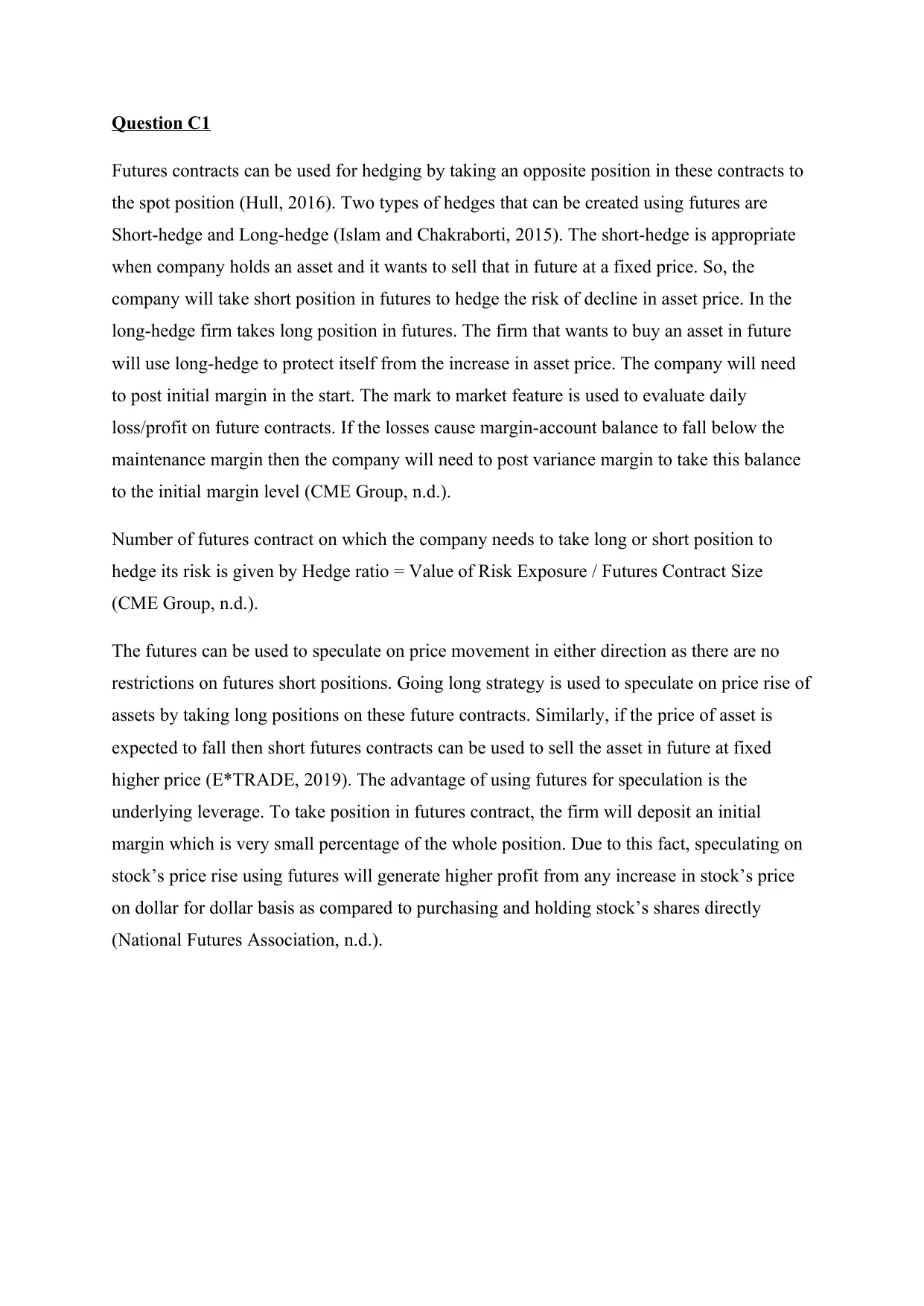
Question C1
Futures contracts can be used for hedging by taking an opposite position in these contracts to
the spot position (Hull, 2016). Two types of hedges that can be created using futures are
Short-hedge and Long-hedge (Islam and Chakraborti, 2015). The short-hedge is appropriate
when company holds an asset and it wants to sell that in future at a fixed price. So, the
company will take short position in futures to hedge the risk of decline in asset price. In the
long-hedge firm takes long position in futures. The firm that wants to buy an asset in future
will use long-hedge to protect itself from the increase in asset price. The company will need
to post initial margin in the start. The mark to market feature is used to evaluate daily
loss/profit on future contracts. If the losses cause margin-account balance to fall below the
maintenance margin then the company will need to post variance margin to take this balance
to the initial margin level (CME Group, n.d.).
Number of futures contract on which the company needs to take long or short position to
hedge its risk is given by Hedge ratio = Value of Risk Exposure / Futures Contract Size
(CME Group, n.d.).
The futures can be used to speculate on price movement in either direction as there are no
restrictions on futures short positions. Going long strategy is used to speculate on price rise of
assets by taking long positions on these future contracts. Similarly, if the price of asset is
expected to fall then short futures contracts can be used to sell the asset in future at fixed
higher price (E*TRADE, 2019). The advantage of using futures for speculation is the
underlying leverage. To take position in futures contract, the firm will deposit an initial
margin which is very small percentage of the whole position. Due to this fact, speculating on
stock’s price rise using futures will generate higher profit from any increase in stock’s price
on dollar for dollar basis as compared to purchasing and holding stock’s shares directly
(National Futures Association, n.d.).
Futures contracts can be used for hedging by taking an opposite position in these contracts to
the spot position (Hull, 2016). Two types of hedges that can be created using futures are
Short-hedge and Long-hedge (Islam and Chakraborti, 2015). The short-hedge is appropriate
when company holds an asset and it wants to sell that in future at a fixed price. So, the
company will take short position in futures to hedge the risk of decline in asset price. In the
long-hedge firm takes long position in futures. The firm that wants to buy an asset in future
will use long-hedge to protect itself from the increase in asset price. The company will need
to post initial margin in the start. The mark to market feature is used to evaluate daily
loss/profit on future contracts. If the losses cause margin-account balance to fall below the
maintenance margin then the company will need to post variance margin to take this balance
to the initial margin level (CME Group, n.d.).
Number of futures contract on which the company needs to take long or short position to
hedge its risk is given by Hedge ratio = Value of Risk Exposure / Futures Contract Size
(CME Group, n.d.).
The futures can be used to speculate on price movement in either direction as there are no
restrictions on futures short positions. Going long strategy is used to speculate on price rise of
assets by taking long positions on these future contracts. Similarly, if the price of asset is
expected to fall then short futures contracts can be used to sell the asset in future at fixed
higher price (E*TRADE, 2019). The advantage of using futures for speculation is the
underlying leverage. To take position in futures contract, the firm will deposit an initial
margin which is very small percentage of the whole position. Due to this fact, speculating on
stock’s price rise using futures will generate higher profit from any increase in stock’s price
on dollar for dollar basis as compared to purchasing and holding stock’s shares directly
(National Futures Association, n.d.).
Paraphrase This Document
Need a fresh take? Get an instant paraphrase of this document with our AI Paraphraser
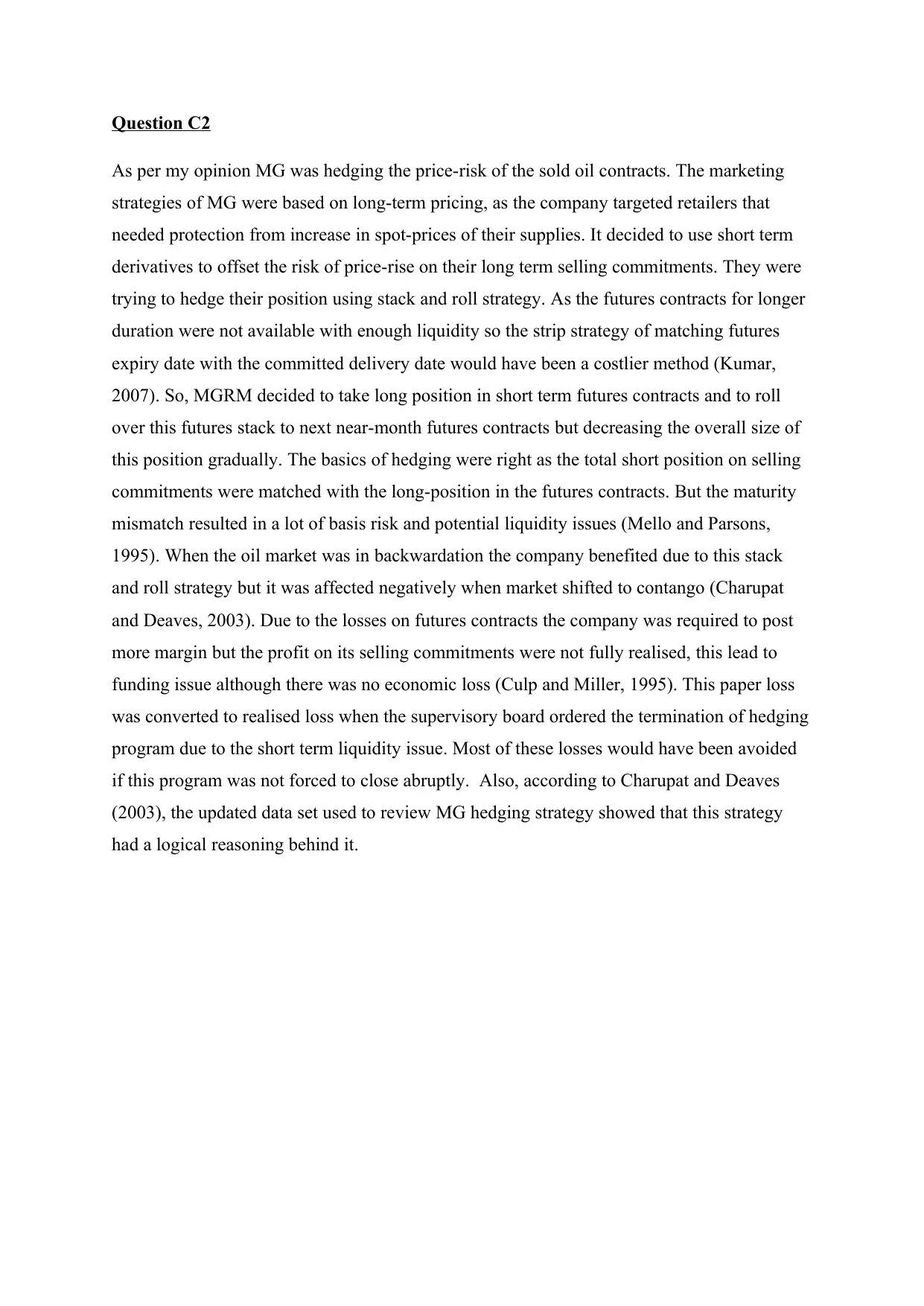
Question C2
As per my opinion MG was hedging the price-risk of the sold oil contracts. The marketing
strategies of MG were based on long-term pricing, as the company targeted retailers that
needed protection from increase in spot-prices of their supplies. It decided to use short term
derivatives to offset the risk of price-rise on their long term selling commitments. They were
trying to hedge their position using stack and roll strategy. As the futures contracts for longer
duration were not available with enough liquidity so the strip strategy of matching futures
expiry date with the committed delivery date would have been a costlier method (Kumar,
2007). So, MGRM decided to take long position in short term futures contracts and to roll
over this futures stack to next near-month futures contracts but decreasing the overall size of
this position gradually. The basics of hedging were right as the total short position on selling
commitments were matched with the long-position in the futures contracts. But the maturity
mismatch resulted in a lot of basis risk and potential liquidity issues (Mello and Parsons,
1995). When the oil market was in backwardation the company benefited due to this stack
and roll strategy but it was affected negatively when market shifted to contango (Charupat
and Deaves, 2003). Due to the losses on futures contracts the company was required to post
more margin but the profit on its selling commitments were not fully realised, this lead to
funding issue although there was no economic loss (Culp and Miller, 1995). This paper loss
was converted to realised loss when the supervisory board ordered the termination of hedging
program due to the short term liquidity issue. Most of these losses would have been avoided
if this program was not forced to close abruptly. Also, according to Charupat and Deaves
(2003), the updated data set used to review MG hedging strategy showed that this strategy
had a logical reasoning behind it.
As per my opinion MG was hedging the price-risk of the sold oil contracts. The marketing
strategies of MG were based on long-term pricing, as the company targeted retailers that
needed protection from increase in spot-prices of their supplies. It decided to use short term
derivatives to offset the risk of price-rise on their long term selling commitments. They were
trying to hedge their position using stack and roll strategy. As the futures contracts for longer
duration were not available with enough liquidity so the strip strategy of matching futures
expiry date with the committed delivery date would have been a costlier method (Kumar,
2007). So, MGRM decided to take long position in short term futures contracts and to roll
over this futures stack to next near-month futures contracts but decreasing the overall size of
this position gradually. The basics of hedging were right as the total short position on selling
commitments were matched with the long-position in the futures contracts. But the maturity
mismatch resulted in a lot of basis risk and potential liquidity issues (Mello and Parsons,
1995). When the oil market was in backwardation the company benefited due to this stack
and roll strategy but it was affected negatively when market shifted to contango (Charupat
and Deaves, 2003). Due to the losses on futures contracts the company was required to post
more margin but the profit on its selling commitments were not fully realised, this lead to
funding issue although there was no economic loss (Culp and Miller, 1995). This paper loss
was converted to realised loss when the supervisory board ordered the termination of hedging
program due to the short term liquidity issue. Most of these losses would have been avoided
if this program was not forced to close abruptly. Also, according to Charupat and Deaves
(2003), the updated data set used to review MG hedging strategy showed that this strategy
had a logical reasoning behind it.
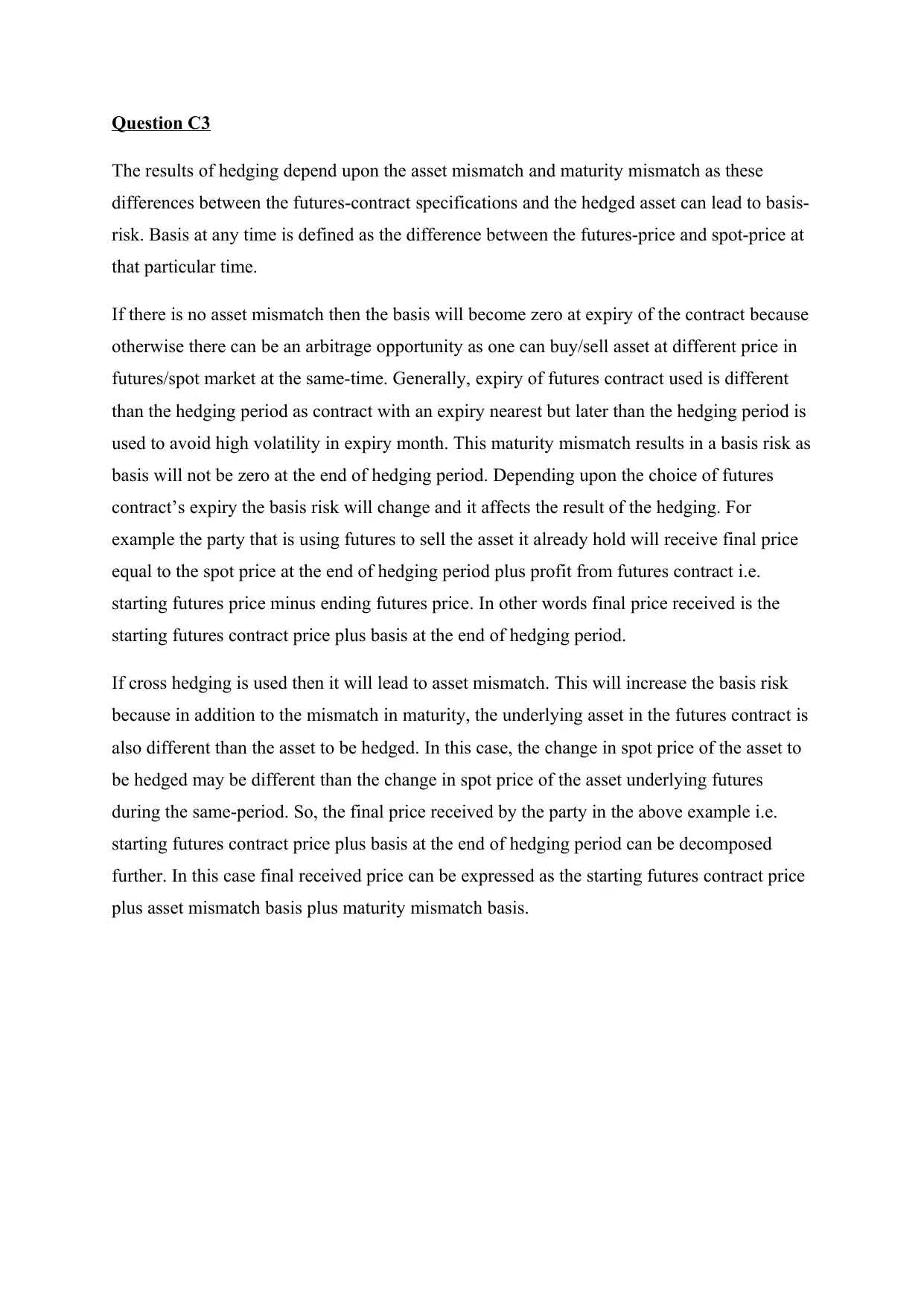
Question C3
The results of hedging depend upon the asset mismatch and maturity mismatch as these
differences between the futures-contract specifications and the hedged asset can lead to basis-
risk. Basis at any time is defined as the difference between the futures-price and spot-price at
that particular time.
If there is no asset mismatch then the basis will become zero at expiry of the contract because
otherwise there can be an arbitrage opportunity as one can buy/sell asset at different price in
futures/spot market at the same-time. Generally, expiry of futures contract used is different
than the hedging period as contract with an expiry nearest but later than the hedging period is
used to avoid high volatility in expiry month. This maturity mismatch results in a basis risk as
basis will not be zero at the end of hedging period. Depending upon the choice of futures
contract’s expiry the basis risk will change and it affects the result of the hedging. For
example the party that is using futures to sell the asset it already hold will receive final price
equal to the spot price at the end of hedging period plus profit from futures contract i.e.
starting futures price minus ending futures price. In other words final price received is the
starting futures contract price plus basis at the end of hedging period.
If cross hedging is used then it will lead to asset mismatch. This will increase the basis risk
because in addition to the mismatch in maturity, the underlying asset in the futures contract is
also different than the asset to be hedged. In this case, the change in spot price of the asset to
be hedged may be different than the change in spot price of the asset underlying futures
during the same-period. So, the final price received by the party in the above example i.e.
starting futures contract price plus basis at the end of hedging period can be decomposed
further. In this case final received price can be expressed as the starting futures contract price
plus asset mismatch basis plus maturity mismatch basis.
The results of hedging depend upon the asset mismatch and maturity mismatch as these
differences between the futures-contract specifications and the hedged asset can lead to basis-
risk. Basis at any time is defined as the difference between the futures-price and spot-price at
that particular time.
If there is no asset mismatch then the basis will become zero at expiry of the contract because
otherwise there can be an arbitrage opportunity as one can buy/sell asset at different price in
futures/spot market at the same-time. Generally, expiry of futures contract used is different
than the hedging period as contract with an expiry nearest but later than the hedging period is
used to avoid high volatility in expiry month. This maturity mismatch results in a basis risk as
basis will not be zero at the end of hedging period. Depending upon the choice of futures
contract’s expiry the basis risk will change and it affects the result of the hedging. For
example the party that is using futures to sell the asset it already hold will receive final price
equal to the spot price at the end of hedging period plus profit from futures contract i.e.
starting futures price minus ending futures price. In other words final price received is the
starting futures contract price plus basis at the end of hedging period.
If cross hedging is used then it will lead to asset mismatch. This will increase the basis risk
because in addition to the mismatch in maturity, the underlying asset in the futures contract is
also different than the asset to be hedged. In this case, the change in spot price of the asset to
be hedged may be different than the change in spot price of the asset underlying futures
during the same-period. So, the final price received by the party in the above example i.e.
starting futures contract price plus basis at the end of hedging period can be decomposed
further. In this case final received price can be expressed as the starting futures contract price
plus asset mismatch basis plus maturity mismatch basis.
⊘ This is a preview!⊘
Do you want full access?
Subscribe today to unlock all pages.

Trusted by 1+ million students worldwide
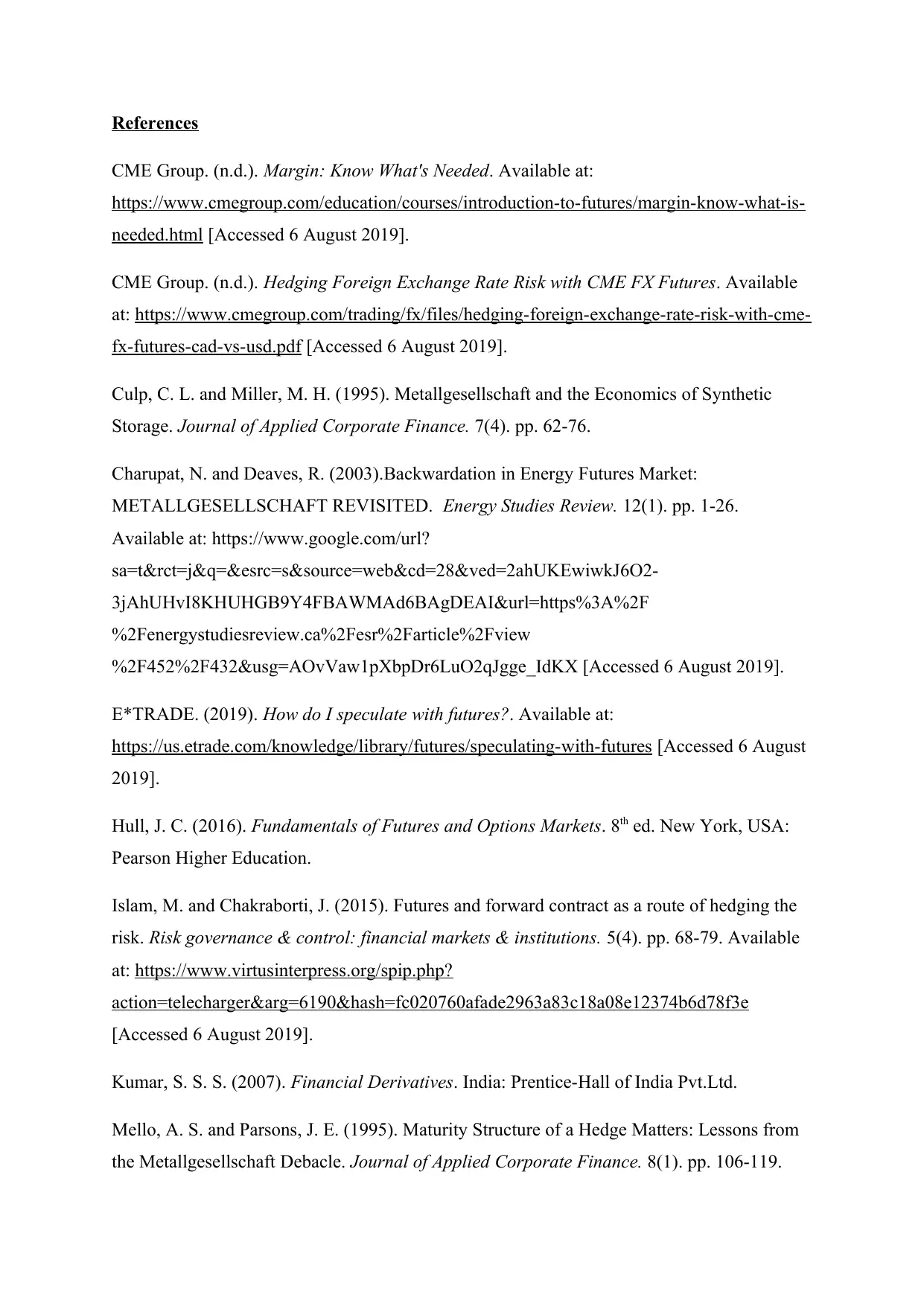
References
CME Group. (n.d.). Margin: Know What's Needed. Available at:
https://www.cmegroup.com/education/courses/introduction-to-futures/margin-know-what-is-
needed.html [Accessed 6 August 2019].
CME Group. (n.d.). Hedging Foreign Exchange Rate Risk with CME FX Futures. Available
at: https://www.cmegroup.com/trading/fx/files/hedging-foreign-exchange-rate-risk-with-cme-
fx-futures-cad-vs-usd.pdf [Accessed 6 August 2019].
Culp, C. L. and Miller, M. H. (1995). Metallgesellschaft and the Economics of Synthetic
Storage. Journal of Applied Corporate Finance. 7(4). pp. 62-76.
Charupat, N. and Deaves, R. (2003).Backwardation in Energy Futures Market:
METALLGESELLSCHAFT REVISITED. Energy Studies Review. 12(1). pp. 1-26.
Available at: https://www.google.com/url?
sa=t&rct=j&q=&esrc=s&source=web&cd=28&ved=2ahUKEwiwkJ6O2-
3jAhUHvI8KHUHGB9Y4FBAWMAd6BAgDEAI&url=https%3A%2F
%2Fenergystudiesreview.ca%2Fesr%2Farticle%2Fview
%2F452%2F432&usg=AOvVaw1pXbpDr6LuO2qJgge_IdKX [Accessed 6 August 2019].
E*TRADE. (2019). How do I speculate with futures?. Available at:
https://us.etrade.com/knowledge/library/futures/speculating-with-futures [Accessed 6 August
2019].
Hull, J. C. (2016). Fundamentals of Futures and Options Markets. 8th ed. New York, USA:
Pearson Higher Education.
Islam, M. and Chakraborti, J. (2015). Futures and forward contract as a route of hedging the
risk. Risk governance & control: financial markets & institutions. 5(4). pp. 68-79. Available
at: https://www.virtusinterpress.org/spip.php?
action=telecharger&arg=6190&hash=fc020760afade2963a83c18a08e12374b6d78f3e
[Accessed 6 August 2019].
Kumar, S. S. S. (2007). Financial Derivatives. India: Prentice-Hall of India Pvt.Ltd.
Mello, A. S. and Parsons, J. E. (1995). Maturity Structure of a Hedge Matters: Lessons from
the Metallgesellschaft Debacle. Journal of Applied Corporate Finance. 8(1). pp. 106-119.
CME Group. (n.d.). Margin: Know What's Needed. Available at:
https://www.cmegroup.com/education/courses/introduction-to-futures/margin-know-what-is-
needed.html [Accessed 6 August 2019].
CME Group. (n.d.). Hedging Foreign Exchange Rate Risk with CME FX Futures. Available
at: https://www.cmegroup.com/trading/fx/files/hedging-foreign-exchange-rate-risk-with-cme-
fx-futures-cad-vs-usd.pdf [Accessed 6 August 2019].
Culp, C. L. and Miller, M. H. (1995). Metallgesellschaft and the Economics of Synthetic
Storage. Journal of Applied Corporate Finance. 7(4). pp. 62-76.
Charupat, N. and Deaves, R. (2003).Backwardation in Energy Futures Market:
METALLGESELLSCHAFT REVISITED. Energy Studies Review. 12(1). pp. 1-26.
Available at: https://www.google.com/url?
sa=t&rct=j&q=&esrc=s&source=web&cd=28&ved=2ahUKEwiwkJ6O2-
3jAhUHvI8KHUHGB9Y4FBAWMAd6BAgDEAI&url=https%3A%2F
%2Fenergystudiesreview.ca%2Fesr%2Farticle%2Fview
%2F452%2F432&usg=AOvVaw1pXbpDr6LuO2qJgge_IdKX [Accessed 6 August 2019].
E*TRADE. (2019). How do I speculate with futures?. Available at:
https://us.etrade.com/knowledge/library/futures/speculating-with-futures [Accessed 6 August
2019].
Hull, J. C. (2016). Fundamentals of Futures and Options Markets. 8th ed. New York, USA:
Pearson Higher Education.
Islam, M. and Chakraborti, J. (2015). Futures and forward contract as a route of hedging the
risk. Risk governance & control: financial markets & institutions. 5(4). pp. 68-79. Available
at: https://www.virtusinterpress.org/spip.php?
action=telecharger&arg=6190&hash=fc020760afade2963a83c18a08e12374b6d78f3e
[Accessed 6 August 2019].
Kumar, S. S. S. (2007). Financial Derivatives. India: Prentice-Hall of India Pvt.Ltd.
Mello, A. S. and Parsons, J. E. (1995). Maturity Structure of a Hedge Matters: Lessons from
the Metallgesellschaft Debacle. Journal of Applied Corporate Finance. 8(1). pp. 106-119.
Paraphrase This Document
Need a fresh take? Get an instant paraphrase of this document with our AI Paraphraser
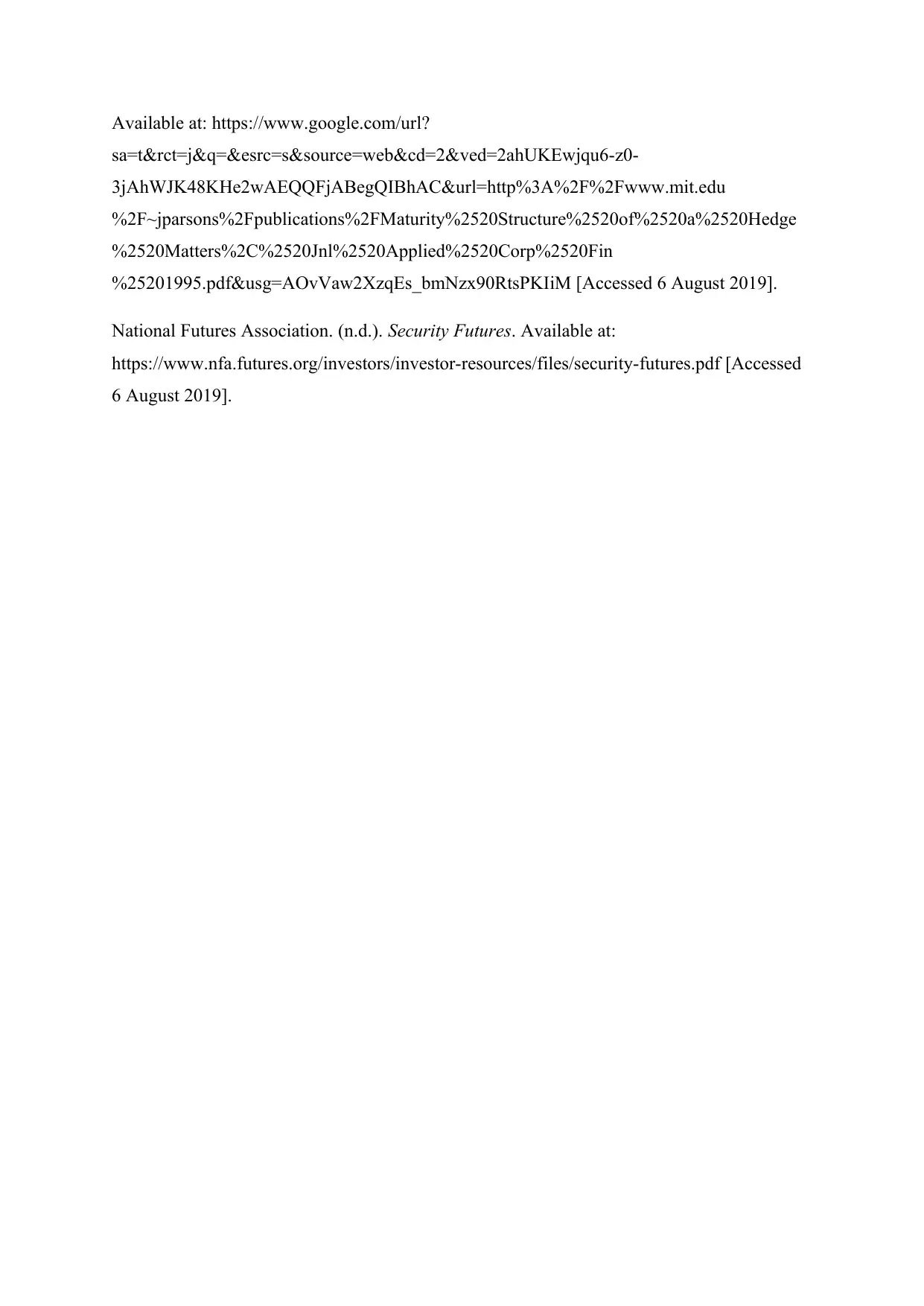
Available at: https://www.google.com/url?
sa=t&rct=j&q=&esrc=s&source=web&cd=2&ved=2ahUKEwjqu6-z0-
3jAhWJK48KHe2wAEQQFjABegQIBhAC&url=http%3A%2F%2Fwww.mit.edu
%2F~jparsons%2Fpublications%2FMaturity%2520Structure%2520of%2520a%2520Hedge
%2520Matters%2C%2520Jnl%2520Applied%2520Corp%2520Fin
%25201995.pdf&usg=AOvVaw2XzqEs_bmNzx90RtsPKIiM [Accessed 6 August 2019].
National Futures Association. (n.d.). Security Futures. Available at:
https://www.nfa.futures.org/investors/investor-resources/files/security-futures.pdf [Accessed
6 August 2019].
sa=t&rct=j&q=&esrc=s&source=web&cd=2&ved=2ahUKEwjqu6-z0-
3jAhWJK48KHe2wAEQQFjABegQIBhAC&url=http%3A%2F%2Fwww.mit.edu
%2F~jparsons%2Fpublications%2FMaturity%2520Structure%2520of%2520a%2520Hedge
%2520Matters%2C%2520Jnl%2520Applied%2520Corp%2520Fin
%25201995.pdf&usg=AOvVaw2XzqEs_bmNzx90RtsPKIiM [Accessed 6 August 2019].
National Futures Association. (n.d.). Security Futures. Available at:
https://www.nfa.futures.org/investors/investor-resources/files/security-futures.pdf [Accessed
6 August 2019].
1 out of 5
Related Documents
Your All-in-One AI-Powered Toolkit for Academic Success.
+13062052269
info@desklib.com
Available 24*7 on WhatsApp / Email
![[object Object]](/_next/static/media/star-bottom.7253800d.svg)
Unlock your academic potential
Copyright © 2020–2025 A2Z Services. All Rights Reserved. Developed and managed by ZUCOL.





